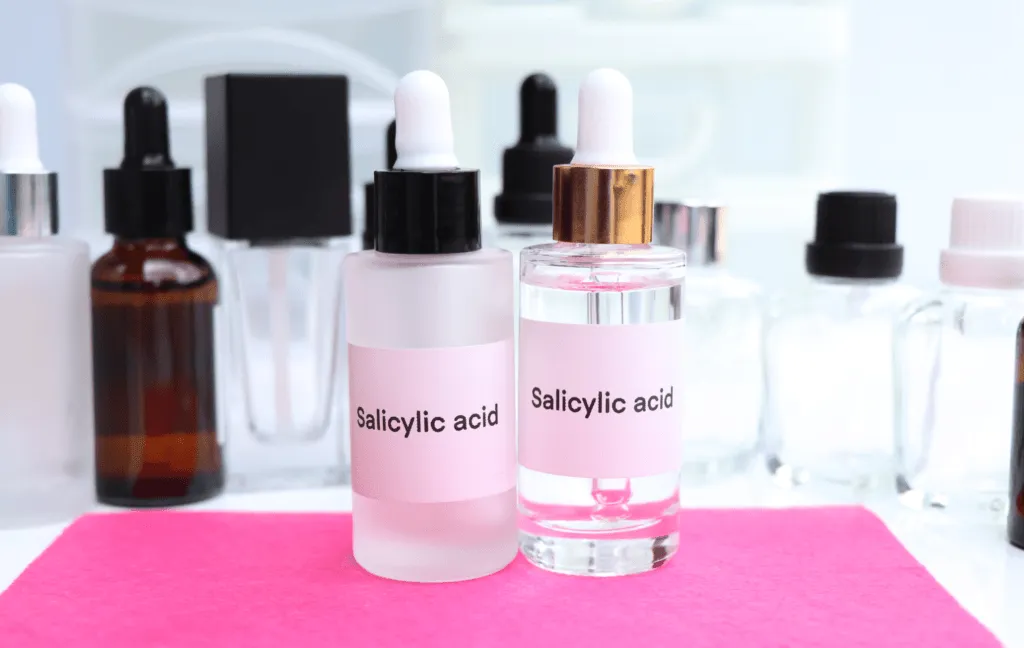Introduction
Combining Salicylic Acid and Vitamin C in your skincare routine offers a powerful synergy. Salicylic Acid, known for its exfoliating properties, helps combat acne and unclog pores. However, the question often arises:
Can I mix salicylic acid and vitamin C? Is there any risk to do this?
Yes, you can mix salicylic acid and vitamin C.
There is a risk of mixing salicylic acid and vitamin C. Mix this and apply it on your skin, May irritate your skin and cause irritation. Combining them directly may neutralize their effectiveness.
In our Skinglem guide, we will step-by-step guide you for mixing salicylic acid and vitamin C. And you will know whether there is any risk in this. So, scroll down.
What Is The Salicylic Acid?
Salicylic acid is a therapeutic topical formulation available as gel, cream, lotion, or solution. It effectively addresses and prevents acne, as well as other skin conditions such as warts, psoriasis, calluses, and corns.
Derived from the bark of the willow tree, it is renowned for its ability to penetrate oil-filled pores, making it effective in treating acne and promoting skin renewal.
Salicylic acid works by dissolving excess sebum, preventing the formation of clogged pores, and addressing various skin concerns, including blackheads and whiteheads.
Additionally, it possesses anti-inflammatory properties, making it a popular choice for combating blemishes and improving overall skin texture. Its exfoliating action helps reveal smoother, clearer skin, making it a key ingredient in many acne-fighting and skincare products.
What Is The Vitamin C?
While Vitamin C is commonly associated with morning orange juice, it’s a crucial nutrient found in various fruits and vegetables. Health experts recommend a daily intake of 75 to 90 mg of dietary Vitamin C.
Since the body doesn’t produce Vitamin C naturally and flushes out any unused amounts daily, replenishing this nutrient is essential.
Though dietary sources contribute, not all Vitamin C reaches the skin. To ensure optimal skin benefits, skincare products with Vitamin C, often listed as L-Ascorbic Acid, become necessary.
Vitamin E, scientifically named Tocopheryl Acetate, is frequently paired with L-Ascorbic Acid in formulations to stabilize the latter, preventing reactions to sunlight and oxygen.
An exemplary Vitamin C serum is the Super C Brightening Serum, featuring 20% L-Ascorbic Acid alongside Kojic Acid, Salicylic Acid, and Hyaluronic Acid. This synergistic blend aims to maximize Vitamin C benefits while addressing skin clarity and hydration.
Is It Safe To Mix Salicylic Acid and Vitamin C Together?
Combining salicylic acid and vitamin C in a skincare routine can be safe for some individuals, but caution is advised due to potential interactions. Salicylic acid generally functions optimally in lower pH levels, while vitamin C prefers higher pH levels.
Directly mixing these ingredients may compromise their stability and efficacy. To use them together, consider applying salicylic acid in the morning and vitamin C in the evening or alternating days. This allows each ingredient to work effectively without directly interacting.
Performing a patch test before combining them is essential to assess individual skin tolerance. If uncertainty persists, seeking advice from a dermatologist can provide personalized recommendations based on your skin type and concerns.
How Can I Mix Salicylic Acid and Vitamin C? 8 Risk-Free Tips
Salicylic acid typically functions optimally in lower pH levels, while vitamin C prefers higher pH levels.
Tips 1. Alternate Days
Yes, you can mix salicylic acid and vitamin C on alternate days as part of your skincare routine. This approach helps prevent potential interactions between the two ingredients, as salicylic acid typically functions optimally in lower pH levels, while vitamin C prefers higher pH levels.
Applying them on separate days allows each ingredient to work effectively without direct interference, maximizing the benefits of both without compromising their stability.
Remember to monitor your skin’s response and adjust the frequency or concentration if any irritation occurs.
Tips 2. Morning and Evening Routine
While it is technically possible to mix salicylic acid and vitamin C in both your morning and evening skincare routines, it’s essential to proceed with caution due to potential interactions.
Apply salicylic acid in the morning routine and vitamin C in the evening. This staggered approach allows each ingredient to work independently without direct interaction.
Always perform a patch test when introducing new products and monitor your skin for any signs of irritation.
Tips 3. Mixing in the Hand
While mixing salicylic acid and vitamin C in your hand before application may be a practical approach, it’s crucial to keep in mind the potential interactions between these ingredients. While mixing in your hand might help to some extent, it may not completely mitigate the risk of pH conflicts.
If you choose to mix them in your hand:
Apply Quickly
Mix the products in your hand right before application to minimize the time they spend in direct contact.
Observe Skin Sensitivity
Pay attention to your skin’s reaction and adjust your routine if you notice any signs of irritation or discomfort.
Remember to perform a patch test before combining these ingredients, and if you have concerns or experience any adverse effects.
https://youtu.be/2KkNq2h8ctY
Tips 4. Apply on Different Areas
Yes, you can mix salicylic acid and vitamin C by applying them to different areas of your face. This method helps minimize the potential interaction between the two ingredients, as salicylic acid is typically best suited for treating specific concerns like acne, while vitamin C is often used for brightening and addressing hyperpigmentation.
However, here’s how you can approach it:
Identify Target Areas:
Determine which areas of your face require salicylic acid for acne or oil control and where you want to address concerns like dark spots with vitamin C.
Apply Salicylic Acid:
Direct the application of salicylic acid to the specific areas where you need it, avoiding overlap with where you plan to apply vitamin C.
Apply Vitamin C:
Apply vitamin C to the designated areas where you want to enjoy its brightening and antioxidant benefits.
Observe Skin Sensitivity:
Monitor your skin for any signs of irritation or adverse reactions, and adjust your routine accordingly.
This targeted approach allows you to reap the benefits of both ingredients without risking potential conflicts. Always perform a patch test when introducing new products, and consult with a dermatologist if you have specific concerns or skin conditions.
Tips 5. Use a Combined Product
Yes, you can use a combined product that contains both salicylic acid and vitamin C. Many skincare formulations are designed to incorporate multiple active ingredients to address various skin concerns.
Using such a product simplifies your routine and ensures that the ingredients are formulated to work together effectively. When choosing a combined product
Check Formulation
Ensure the product is formulated to maintain the stability and effectiveness of both salicylic acid and vitamin C.
Follow Instructions
Adhere to the product’s usage instructions regarding application frequency and any specific considerations.
Perform Patch
Test Before applying the product to your entire face, perform a patch test to check for any adverse reactions.
Monitor Skin
Response Pay attention to how your skin responds over time and adjust your routine if needed.
Using a combined product can be convenient, especially if you have specific concerns that both salicylic acid and vitamin C address.
Tips 6. Use a Stabilizer
Using a stabilizer when mixing salicylic acid and vitamin C may help mitigate potential conflicts between these ingredients. Here are a few considerations:
Neutral pH Buffer
Incorporate a neutral pH product, such as a basic moisturizer or a hydrating serum, between the applications of salicylic acid and vitamin C. This can act as a buffer, minimizing potential interactions.
Combined Products
Opt for skincare products specifically formulated to combine salicylic acid and vitamin C. These formulations often include stabilizers and emollients to ensure the compatibility of the ingredients.
Layering Technique
Apply the product with the lower pH (e.g., salicylic acid) first, allowing it to absorb, and then apply the product with the higher pH (e.g., vitamin C).
Consult a Dermatologist
Seek professional advice from a dermatologist, who can guide you on the use of stabilizers or recommend alternative products based on your skin type and concerns.
Tips 7. Use a Neutral pH Product
Yes, using a neutral pH product between salicylic acid and vitamin C can be a helpful strategy to minimize potential conflicts between these ingredients.
Since salicylic acid typically functions optimally in lower pH levels, while vitamin C prefers higher pH levels, introducing a neutral pH product between them acts as a buffer, reducing the risk of pH-related instability.
Here’s how you can incorporate a neutral pH product.
Choose a Neutral Product
Select a skincare product with a neutral pH, such as a basic moisturizer or a hydrating serum, that doesn’t lean strongly towards acidity or alkalinity.
Apply Between Steps
After applying salicylic acid, follow it with the neutral pH product before applying vitamin C. Allow each product to absorb before proceeding to the next step.
Monitor Skin Response
Pay close attention to how your skin responds to this layering technique. If you encounter any irritation or discomfort, modify your skincare routine as needed.
Perform Patch Test
Before applying the products to your entire face, perform a patch test to check for any adverse reactions.
Using a neutral pH product as a buffer can help create a more harmonious environment for both salicylic acid and vitamin C.

Tips 8. Layering Technique
When considering mixing salicylic acid and vitamin C in your skincare routine, a layering technique can help minimize potential conflicts and ensure the effectiveness of both ingredients. Here’s a suggested layering technique:
1. Cleanse
Start with a gentle cleanser to prepare your skin for the upcoming products.
2. Salicylic Acid
Apply salicylic acid first. This ingredient is best used early in your routine as it typically functions optimally in lower pH levels.
3. Neutral pH Product (Optional)
Consider applying a neutral pH product, like a basic moisturizer or hydrating serum, to create a buffer between salicylic acid and vitamin C.
4. Vitamin C
Follow with the application of vitamin C. This antioxidant is more effective in slightly higher pH levels.
5. Moisturizer
Use your usual moisturizer to seal in hydration.
6. Sunscreen (Morning Routine)
Finish your morning routine with a broad-spectrum sunscreen, especially if using these ingredients in the morning.
Key Points
Allow Absorption Time
Give each product a few minutes to absorb before applying the next layer.
Patch Test
Before incorporating new products or changing your routine, perform a patch test to check for any adverse reactions.
Consult a Dermatologist
If you have specific skin concerns or conditions, seeking advice from a dermatologist ensures a personalized approach.
By following this layering technique, you can potentially mix salicylic acid and vitamin C in your routine while minimizing the risk of pH conflicts and maximizing the benefits of both ingredients.
However, Always perform a patch test when introducing new products, and consult with a dermatologist if you have specific concerns or skin conditions.
What Type Of Skin Should You Use Mix Vitamin C And Salicylic Acid
The combination of vitamin C and salicylic acid can be suitable for certain skin types, especially for those dealing with specific concerns. Here’s a guideline for skin types that may benefit from this combination:
Oily and Acne-Prone Skin
- Both vitamin C and salicylic acid address excess oil production and acne.
- Vitamin C helps brighten skin and reduce hyperpigmentation.
- Salicylic acid exfoliates, unclogs pores, and targets acne.
Combination Skin
- Suitable for those with a mix of oily and dry areas on the face.
- Helps balance oil production while addressing potential breakouts.
Dull or Uneven Skin Tone
- Vitamin C contributes to a brighter and more even complexion.
- Salicylic acid aids in exfoliation, promoting skin renewal.
Normal Skin with Occasional Breakouts
- Beneficial for maintaining clear skin and preventing occasional breakouts.
- The combination can address both preventive and corrective skincare needs.
It’s essential to monitor skin sensitivity and introduce the products gradually. If any irritation occurs, consider adjusting the frequency or concentration of each ingredient.
Additionally, always perform a patch test and consult with a dermatologist, especially if you have sensitive or reactive skin.

What Are The Skin Benefits And Side Effects?
Mixing salicylic acid and vitamin C has both benefits and harms to the skin. This is not always good for mixed skin. It has both positive and negative aspects.. Let’s take a look at some of the benefits and harms.
Benefits
Here are some skin benefits of mixing Salicylic acid and vitamin C:
Acne Treatment:
Salicylic acid targets acne by unclogging pores and reducing inflammation, while vitamin C helps in fading post-acne hyperpigmentation.
Brightening:
Vitamin C contributes to a brighter complexion by reducing dark spots and promoting skin radiance.
Exfoliation:
Salicylic acid’s exfoliating properties, combined with vitamin C, enhance skin renewal, resulting in a smoother texture.
Oil Control:
Salicylic acid regulates oil production, complemented by the antioxidant properties of vitamin C for a balanced complexion.
Anti-Aging:
Vitamin C promotes collagen synthesis, aiding in skin firmness and elasticity, while salicylic acid exfoliates, reducing the appearance of fine lines and wrinkles.
Possible Side Effects
Here are some Skin possible side effects with a mix of salicylic acid and vitamin C:
Skin Irritation:
Both ingredients can cause irritation, especially in individuals with sensitive skin. Start with lower concentrations and monitor skin response.
Dryness:
Overuse or high concentrations may lead to dryness, requiring adequate moisturization.
Sensitivity to Sun: Both salicylic acid and vitamin C can increase sensitivity to sunlight. Regular sunscreen use is crucial.
Final Think
Vitamin C helps brighten and protect the skin, while salicylic acid helps exfoliate and clean up the look of skin prone to blemishes. Given all of these advantages, combining the two components makes sense.
Although the combination of these nutrients can yield more advantages, we advise beginning cautiously. Given how potent these chemicals are, it could take some time for your skin to get used to them both.
In Skingleam whole post, we told you how can you mix salicylic acid and vitamin C? And I have given you 8 tips on how to mix without risk.
And we have given you 8 tips on how to mix without risk. What kind of skin do you use mixed salicylic acid and vitamin C? And if you use mixed salicylic acid and vitamin C, what benefits will you get and what can be harmed? We talked about all these things.
Adopting strategies such as alternating days, using a neutral pH buffer, or selecting combined products can help ensure the stability and effectiveness of both salicylic acid and vitamin C. Always monitor your skin’s response, perform patch tests, and consult with a dermatologist for personalized advice, especially if you have specific skin concerns or conditions.
Resources
- nlinelibrary.wiley.com/doi/abs/10.1111/j.1365-2133.1976.tb00825.x
- skinpharm.com/blogs/blog/salicylic-acid-and-vitamin-c
- ncbi.nlm.nih.gov/pmc/articles/PMC3673383/
- urbanskinrx.com/blogs/expert-advice/is-it-safe-to-mix-salicylic-acid-and-vitamin-c
- empyri.com/blogs/empyri-blog/mix-salicylic-acid-and-vitamin-c


[…] oil-filled pores and exfoliating inside the pore lining. Salicylic acid is a widely used BHA in acne treatments. Effective for treating acne-prone skin by reducing […]
[…] skincare actives include antioxidants like vitamins C and E, known for their protective effects against free radicals; retinoids such as retinol, […]
[…] each of these compounds boasts remarkable benefits for the skin individually, the question arises: Can you use Vitamin C and Salicylic Acid together? Let’s delve deeper into this topic to uncover the truth behind this skincare […]
[…] desired results without adverse effects. One common query arises regarding the combination of Vitamin C with salicylic acid. This article delves into the intricacies, benefits, and precautions associated with using these […]
[…] the pursuit of flawless skin, many individuals turn to a myriad of skincare products. Among these, salicylic acid and vitamin C stand out as popular choices. But can these two powerhouse ingredients be used together? […]
[…] compounds like salicylic acid and vitamin C. This article delves into the question: Can I use salicylic acid and vitamin C together? Let’s […]
[…] salicylic acid. But can these powerhouses be used together? Let’s delve into the synergy of vitamin C and salicylic acid and uncover the secrets behind their combined […]
Your point of view caught my eye and was very interesting. Thanks. I have a question for you.
Hey there! Do you know if they make any plugins to help with SEO?
I’m trying to get my site to rank for some targeted keywords
but I’m not seeing very good gains. If you know of any please share.
Many thanks! You can read similar text here: Lista escape room